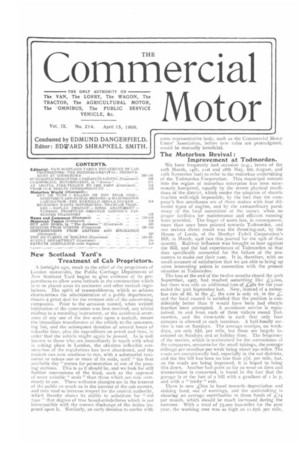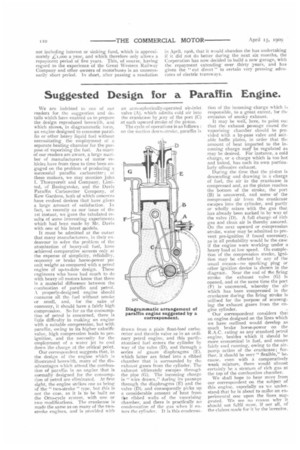The Motorbus Revival: Improvement at Todmorden.
Page 1

Page 2

If you've noticed an error in this article please click here to report it so we can fix it.
We have frequently had occasion (e.g., issues of the 12th March, i4th, 2 1 st and 28th May, 6th August, and t2th November last) to refer to the motorbus undertaking of the Todmorden Corporation. This municipal venture into the region of motorbus enterprise has been enormously hampered, equally by the severe physical conditions of the district, which render the adoption of electric traction well-nigh impossible, by the fact that the company's five omnibuses are of three makes with four different types of engine, and by the extraordinary parsimony of the local committee at the outset, when no proper facilities for maintenance and efficient running were provided. The finger of scorn has, in consequence, more than once been pointed towards Todmorden, and one serious direct result was the throwing-out, by the House of Lords, of the Merthyr Tydvil Corporation's Bill, in March, iyo8 (see this journal for the igth of that month). Railway influence was brought to bear against the Bill, and the bad experiences of Todmorden to that date specifically accounted for the failure of the promoters to make out their case. It is, therefore, with no small measure of satisfaction that we are able to bring up some interesting points in connection with the present situation at Todmorden.
The loss at the end of the twelve months closed the 3oth September, 1907, had reached something like ,-3,000, but there was only an additional loss of .482 for the year ended the 3oth September last. Now, instead of a motor bus rate of 8d, in the the rate is only 2d. in the and the local council is satisfied that the position is considerably better than it would have been had electric traction been attempted. A 20-minute service is maintained, to and from each of three valleys round Todmorden, and the time-table is such that only four minutes is allowed at each terminus. A half-hourly service is run on Sundays. The average receipts, on weekdays, are only 60, per mile, but these are largely increased on Sundays and at holiday time. The frequency of the service, which is maintained for the convenience of the ratepayers, accountsfor the small takings, the average mileage per omnibus per week being about 290 miles, The roads are exceptionally bad, especially in the out districts,
and the tire bill has been no less than per mile, but, as the roads are being improved, it is hoped to bring this down. Another bad point so far as wear on tires and transmission is concerned, is found in the fact that the garage is at the foot of a hill with a gradient of i in 7, and with a " tricky " exit.
There is now .8oci in hand towards depreciation and sinking fund, out of earnings, and the undertaking is showing an average contribution to those funds of 424 per month, which should be much increased during the summer. With a total of 75,000 bus-miles for the past year, the working cost was as high as I ).67d. per mile,
not including interest or sinking fund, which is approximately Zi,000 a year, and which therefore only allows a repayment period of five years. This, of course, having regard to the experience of the Great Western Railway Company and other owners of motorbuses is an unnecessarily short period. In short, after passing a resolution in April, 19°8, that it would abandon the bus undertaking if it did not do better during the next six months, the Corporation has now decided to build a new garage, with the repayment extending over thirty years, and has given the " cut direct " to certain very pressing advocates of electric tramways.


















